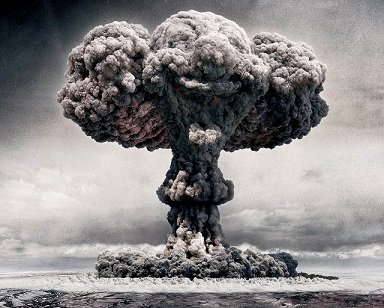Nuclear blasts fun.
You know, it’s estimated that there are over 10,000 nuclear weapons in the world.
10,000. And depending on the size of the bomb, it could take as little as 2,500 to completely destroy all of North America and 13,000 more to destroy the planet. It’s beautiful out here isn’t it?
Well, we should probably get inside bunkers and start preparing...
We’ve all seen footage of nuclear bombs being detonated and it is jaw dropping, the force of it, the power. And we’ve seen the damage it causes to anything in the surrounding area. But we tend to forget just how devastating a nuclear bomb is, really. For example: Since 1923 there have been over 53,000 deaths from airplane accidents. There have been over 220,000 deaths from nuclear bombs, and that’s only from 2 of them. The shear amount of destruction and death that a nuclear bomb is capable of, created a new unit of measurement in the 1950s...a megadeath. 1 megadeath is equal to 1 million fatalities by nuclear explosion. To understand just how incredibly large and impacting one explosion would be, we have to look no further than the most powerful nuclear device detonated by the United States, Castle Bravo.
Castle Bravo had 15 megatons of TNT and the fireball it created was about 4 miles wide. The mushroom cloud went 24.6 miles high and stretched for more than 60. But what we don’t see is what happens after the initial blast. Once the cameras stop rolling, it no longer exists for us but the effects of it are still there.
In the case of Castle Bravo, two hundred billion pounds of coral reef and sea floor were ejected.
A large amount of debris is pulled up and into the mushroom cloud, becoming radioactive, and creating fallout. As the cloud gets higher, the winds get stronger and carry the fallout away from the blast site, like radioactive seeds. Tiny particles of radioactive material can be pulled into the upper atmosphere and travel thousands of miles from the initial blast. The Island of Rongelap was 115 miles from the explosion and was evacuated 2 days after. White dust, fallout, rained down upon the inhabitants.
They couldn’t return for 3 years and then had to leave again because the island still wasn’t safe.
What’s scary about a nuclear bomb isn’t just the initial blast, I mean, that we can see. It’s the things we can’t see like the gamma rays or the radioactive dust that looks like any other dust. By the time you feel the effects of radiation damage nothing can be done to reverse it. Strontium-90, is known as a bone seeker and is released by thermonuclear explosions. It gets into the soil and is absorbed by the plants. Then by the animals that eat those plants, and then by the humans that eat those animals. Once inside it mimics calcium and starts to build up in our bones. Since it has a half-life of 29 years, it keeps emitting radiation causing bone cancer and leukemia. And, to me, the most unnerving part of nuclear war and fallout are the effects that are not immediate, that you don’t even know about until it is too late. Or that you don’t even know about because they affect someone further down your family line...after you’re already gone. There’s an obstacle course to recovery that survivors of large scale nuclear attacks face: 1-2 days — Blast and Thermal and then all the way to 2 to several generations with genetic effects When it comes to these bombs, the intent isn’t entirely just to destroy those within the blast radius or even those who die within a few days from radiation poisoning.
The intent is to destroy everything they have ever known, to make their lives unlivable.
As president Eisenhower said :
“You can’t have this kind of war. There just aren’t enough bulldozers to scrape the bodies off the streets.”
And there is actually something more frightful than actually detonating a nuclear bomb...the idea of detonating it. During the Cold War between the United States and the Soviet Union it was more about the capabilities and intentions the enemy thinks you have. It becomes a war of persuasion over a war of action. But there is another tactic, a doctrine of military strategy that boils down to if you shoot at me, I’ll shoot at you. But in this case, if you fire weapons of mass destruction at me, I will fire all of mine at you to make sure that neither side wins, that everyone loses. It sounds crazy doesn’t it? But it’s not crazy, it’s MAD (Mutually Assured Destruction). If something like that were to happen we could be safe in underground bunkers, with cans of food and our own water filtration system.
But how long would you have to stay underground? And would you even be safe there? Because you could always find yourself meeting a Nuclear Bunker Buster. I’m going to be honest with you...surviving a fallout isn’t really the question. Of course you could survive given the right preparations, humans are resilient and will perceiver through the toughest obstacles. A lethal dose of radiation wouldn’t turn you into a ghoul, it would turn you into a corpse. So the real question that you have to ask yourself in this situation isn’t if you could survive a fallout, it’s if you’d want to. I guess it’s getting to be that time. Einstein said something relevant to this.
He said “I know not with what weapons World War III will be fought, but World War IV will be fought with sticks and stones.”
With thanks to Jake Roper.

I was looking for some metal music article . nuclear blast is record label hahaha.
still very nice post . big up